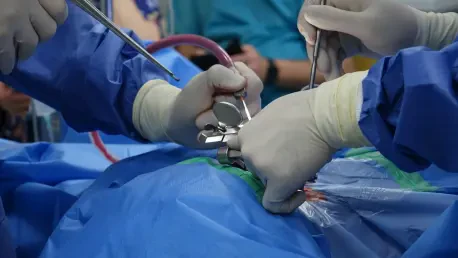Surgical advancements often hinge on tools that balance innovation with practicality, and one such tool has recently captured the attention of healthcare professionals across Australia and New Zealand. With operating rooms under constant pressure to optimize efficiency while ensuring patient safety, the introduction of a hemostatic solution that simplifies logistics and delivers reliable results is no small feat. Baxter Healthcare’s HEMOPATCH Sealing Hemostat, with its groundbreaking room temperature storage capability, has sparked discussions among surgical teams and industry leaders. This roundup gathers diverse perspectives, tips, and reviews from various experts to explore how this product is reshaping surgical practices and what it means for the future of patient care.
Uncovering the Impact of Room Temperature Innovation
Logistical Breakthroughs in the Operating Room
The ability of HEMOPATCH to be stored at room temperature has been hailed as a significant logistical advancement by hospital administrators in Australia and New Zealand. Unlike traditional hemostatic agents requiring refrigeration, this feature eliminates the need for specialized cooling equipment, reducing operational costs and simplifying inventory management. Feedback from surgical support staff highlights how this change allows for faster access during critical procedures, minimizing delays in high-pressure environments.
Another angle comes from supply chain specialists who emphasize the reduced risk of product spoilage due to temperature mishandling. This reliability ensures that hospitals, especially in remote areas with limited infrastructure, can maintain a steady supply without fear of compromised efficacy. The consensus among these professionals is that such an innovation sets a precedent for future medical devices to prioritize accessibility alongside performance.
Addressing Doubts About Efficacy
Despite the enthusiasm, some clinicians initially expressed skepticism about whether a room temperature product could match the effectiveness of refrigerated alternatives. However, many have since noted that Baxter’s rigorous testing and quality assurance protocols have alleviated these concerns. Reports from operating room teams suggest that the product maintains consistent hemostatic performance across various conditions, reinforcing trust in its design.
Further insights from medical technology analysts point to the robust research backing HEMOPATCH, which demonstrates no loss in potency without cold storage. This perspective underscores the importance of transparent communication from manufacturers to address hesitations and build confidence among healthcare providers. The dialogue around this feature reveals a broader push for innovations that do not sacrifice quality for convenience.
Clinical Performance Across Surgical Fields
Effectiveness in Bleeding Control
Surgeons specializing in urological procedures have widely praised HEMOPATCH for its ability to manage mild to moderate bleeding, particularly in cases involving venous surfaces. Feedback from practitioners in Queensland highlights how the absorbable collagen pad provides rapid sealing, enhancing surgical precision and reducing patient recovery times. This reliability has been described as a critical factor in boosting confidence during complex operations.
In contrast, some vascular surgeons have pointed out limitations, noting that the product is not suited for severe, pulsatile bleeding scenarios. This candid observation helps frame HEMOPATCH as a targeted tool rather than a universal solution, guiding its appropriate application in specific contexts. The balance of strengths and constraints shared by these professionals offers a nuanced view of its clinical utility.
A recurring theme among reviews is the emphasis on patient safety, with many clinicians appreciating how the product minimizes complications when used correctly. This alignment with safety priorities has encouraged broader adoption in hospitals aiming to standardize effective hemostatic options. Such insights reflect a collective focus on tailoring tools to specific surgical needs.
Versatility and Future Applications
The adaptability of HEMOPATCH across specialties like cardiovascular surgery and dura closure has been a focal point for multidisciplinary surgical teams. Experts in neurosurgery have noted its value in addressing small dural defects, while cardiac specialists commend its role in tissue sealing during open procedures. This cross-specialty appeal positions the product as a versatile asset in diverse operating environments.
Market analysts tracking healthcare trends in Australia and New Zealand have observed a steady rise in adoption, attributing it to the product’s long shelf life of up to 36 months. This durability, combined with growing trust among clinicians, suggests potential for setting new benchmarks in surgical tool design globally. However, opinions vary on whether scaling this innovation to different healthcare systems with unique challenges will require additional customization.
Some forward-thinking surgeons speculate that ongoing refinements could expand HEMOPATCH’s applications, potentially influencing minimally invasive techniques over the next few years, from 2025 to 2027. This optimism is tempered by calls for continuous evaluation to ensure that versatility does not overstep established safety boundaries. These discussions highlight an eagerness to explore future possibilities while remaining grounded in current realities.
Safety and Best Practices in Implementation
Navigating Contraindications and Risks
Safety remains a cornerstone of the conversation surrounding HEMOPATCH, with clinical educators stressing the importance of understanding contraindications, such as hypersensitivity to bovine proteins or the dye brilliant blue. Insights from patient safety advocates underline the need for thorough preoperative assessments to prevent adverse reactions, ensuring that the product is used only in suitable cases.
Additional warnings from surgical trainers focus on avoiding application near sensitive areas like the spinal cord due to the risk of expansion upon liquid absorption, which could lead to neural damage. These cautions are seen as vital for maintaining the product’s reputation as a safe option when guidelines are followed. The shared emphasis on education reflects a commitment to balancing innovation with responsibility.
Hospital policymakers also weigh in, advocating for clear protocols to prevent misuse, such as intravascular application or reliance on HEMOPATCH in place of meticulous surgical techniques. Their perspective reinforces the need for comprehensive training programs to align usage with manufacturer recommendations. This collective input shapes a framework for safe integration into hospital workflows.
Industry Standards and Transparency
Comparisons to industry norms reveal that Baxter’s transparency about precautions stands out as a model for other medical device companies. Regulatory consultants note that detailed risk information provided with HEMOPATCH fosters trust among clinicians, setting a high standard for disclosure in the sector. This openness is viewed as a driver for informed decision-making in surgical settings.
Some healthcare compliance officers suggest that evolving safety guidelines could further influence how such products are applied, especially in emerging surgical techniques. They advocate for ongoing dialogue between manufacturers and medical boards to anticipate regulatory shifts. This proactive stance is seen as essential for sustaining confidence in innovative tools over time.
A final point from risk management specialists highlights the importance of post-market surveillance to monitor long-term outcomes and refine safety protocols. Their input underscores a broader industry trend toward continuous improvement, ensuring that patient well-being remains at the forefront of technological advancements. These varied viewpoints collectively strengthen the case for responsible innovation.
Key Takeaways from the Surgical Community
The roundup of opinions reveals a strong consensus on the transformative potential of HEMOPATCH, particularly due to its room temperature storage and reliable hemostasis in mild to moderate bleeding scenarios. Surgeons across specialties value its versatility, while administrative and safety experts appreciate the logistical ease and transparent risk communication. These diverse insights paint a picture of a product that addresses multiple facets of surgical care with notable success.
Practical tips from the field include integrating HEMOPATCH into hospital protocols through targeted staff training on its indications and limitations. Clinical leaders suggest pairing its use with existing best practices rather than as a standalone solution, ensuring that surgical precision remains paramount. This advice aims to maximize benefits while mitigating risks in daily practice.
A recurring recommendation from healthcare strategists is to leverage data from ongoing usage to refine application techniques and share learnings across institutions. This collaborative approach is seen as a way to enhance patient outcomes while maintaining rigorous safety standards. The collective wisdom gathered here offers a roadmap for optimizing the impact of such innovations in real-world settings.
Reflecting on a Milestone in Surgical Advancement
Looking back, the discussions and feedback surrounding Baxter’s HEMOPATCH Sealing Hemostat underscore a pivotal moment in surgical care within Australia and New Zealand. The diverse perspectives from clinicians, administrators, and safety experts highlight how a single innovation tackles longstanding challenges in logistics and clinical performance. This roundup captures a shared enthusiasm for a tool that bridges practicality with patient-centered outcomes.
Moving forward, surgical teams are encouraged to deepen their engagement with such advancements by participating in cross-regional knowledge exchanges to refine best practices. Hospitals might consider establishing dedicated feedback loops with manufacturers to address emerging needs or concerns promptly. Additionally, investing in continuous education will ensure that the benefits of tools like HEMOPATCH are sustained through informed and precise application. These steps pave the way for a more adaptive and responsive surgical landscape.









